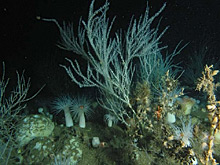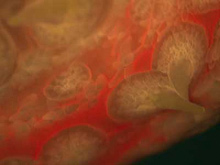
As the sun sets on the last night of our exploration, the entire science party can be proud of what we have accomplished. Click image for larger view.
Mission Summary: Exploration in Its Purest Form
August 17, 2004
News Flash: ![]() The Eye-In-The-Sea camera captures giant isopods and a hungry six-gill shark.
The Eye-In-The-Sea camera captures giant isopods and a hungry six-gill shark.
Edie Widder
Chief Scientist
Operation Deep Scope
To say that Operation Deep Scope was a success would be an understatement.
We are returning with an embarrassment of riches – enough data to keep
us all busy for some time. The emphasis on this cruise has been to peer
into the depths of the ocean with new technological eyes. Our explorations
have been richly rewarded with remarkable visions: giant predators such
as ![]() six-gill
sharks and a deep-sea squid,
six-gill
sharks and a deep-sea squid, ![]() fluorescent
fish and animals, and
fluorescent
fish and animals, and ![]() flashing
corals. We have also gained new insights into
flashing
corals. We have also gained new insights into ![]() how
predators locate invisible prey as well as how we can begin to open
a window into the
how
predators locate invisible prey as well as how we can begin to open
a window into the ![]() secret
goings on of the dark depths.
secret
goings on of the dark depths.
Deep Scope has been exploration in its purest form – something that is all too rare. Limited funding for marine science has necessitated a conservative approach, where only those projects that seem assured of significant and financially rewarding results receive support. Exploration of the sort we have just completed often yields rich and unexpected rewards. At the very least, it teaches us to wonder at the beauty of our planet.
The fast-paced world we live in today often frowns upon those of us who want to stop, look, and listen to what nature has to teach us. Many people seem to think we have learned enough from our planet, and that now we can push on, regardless. Nothing could be further from the truth (as the mess we leave in our wake clearly demonstrates). We have much to learn from the animals that have inhabited this place for millions of years before us, both in terms of their tricks for survival and how to prevent their disappearance. We must protect and cherish this world, or we will lose the exciting innovations of nature, even before we discover them.

The deep-sea floor holds many beautiful scenes, such as this one. Exploring how plants and animals have adapted to life in this extreme environment can open doors to a greater understanding of our planet. Click image for larger view.
![]() Click here
to view a video of the bamboo coral and surrounding area.
Click here
to view a video of the bamboo coral and surrounding area.
A vast volume of our oceans remains unexplored, and it is thrilling to think what mysteries have yet to be revealed. The spirit of pure exploration is one we can afford to invest in. Indeed, we cannot afford not to.
























